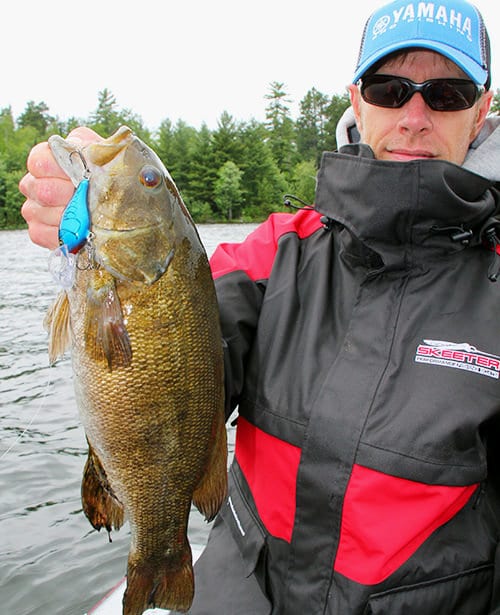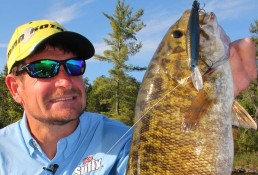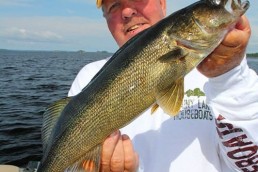Spring Smallies? Answer: Rainy Lake
SHARE THIS POST
When considering an early-season smallmouth bass excursion, what’s the first factor that normally comes into play? Where, of course. In my mind, Rainy Lake always pops to the forefront.
With thousands of lakes to pick from, you may wonder, why Rainy? I could write why, but that wouldn’t leave any room to talk about catching fish. But here’s a simplified shortlist: large quantities of large fish; a lot of prime early-season water, yet protected so you won’t get blown off the lake by the common spring winds; relatively light fishing pressure; and it’s an absolutely beautiful lake.
There are plenty of lakes that share some of those qualities, but a scant few that possess them all. My favorite time to get to Rainy Lake is practically anytime, but the pre-spawn period, complete with fat and eager-to-bite bronzebacks, is hard to beat.

Once the ice comes off the lake and the water starts to warm a bit, smallmouths begin to think about spawning. They don’t jump right up on the flat and get after it, mind you, but they do start migrating to the adjacent transitional areas, and at times, feed quite aggressively to prepare for the rigors of the spawn. We want to target the first break that transitions from the shallow, sand and gravel spawning flats, into deeper water. On Rainy, these flats generally run 2 to 8 feet deep, and then break into 12 to 20 feet. The bass roam these breaks, sometimes up on the top edge or at the base, or suspended slightly off the edge, feeding opportunistically on crayfish, perch, smelt and various minnows. Specific structural features on the break, such as inside and outside turns, points, larger boulders and substrate changes, will often concentrate and hold the fish in that specific area. Simply fish the break fairly quickly, searching for these “spots on the spot.” When you encounter fish, you can slow down and fish the area more thoroughly. Smallies rarely move alone during this time, and the bites usually come in bunches.
There are a few different presentations that work pretty well pre-spawn, but day in and day out, when it comes to walking the line between covering water and triggering bites, there is no better bait than a suspending jerkbait. If I could bring one lure to Rainy to fish pre-spawn smallies, it would be a jerkbait; if I could bring two, it would be another jerkbait (after wearing out the first).
There are some things to consider when selecting jerks for pre-spawn smallmouths: depth, action, size and color. Depth and action are arguably the most important. Jerkbaits aren’t like crankbaits in that you have a huge selection of varying depths, but there are generally shallow and deep models, and both have their place depending on fish location. When jerkbaiting cold water, it’s important to present the bait near, but not below, the fish.
Action is a different story. There are hundreds of different jerkbaits available, (especially when size is taken into consideration), and each has their own, unique action. I recommend tossing a “family” of jerkbaits. Many manufacturers have several models in the lineup to account for various conditions, and if you have a favorite jerkbait, chances are it has some siblings. For several years now, I have been throwing the various Rapala iterations of suspending jerkbaits for my cold-water smallie fishing, and with the introduction of the Shadow Rap last year, the family has become pretty hard to beat as a group. The three that cover me for any condition are the Husky Jerk, which has been around forever, but tight, subtle action, is still my favorite for very cold water and post-frontal, negative fish, the X-Rap, polar opposite of the husky, with a wide and erratic action that excels at triggering more aggressive fish, especially during warming trends and finally the deeper running version of the Shadow Rap, which falls somewhere between the other two and is very versatile—pull it gently for a subtle action or snapped on slack line for a wilder action rivaling the X-Rap.
Are you enjoying this post?
You can be among the first to get the latest info on where to go, what to use and how to use it!
It’s now the bait that I normally start jerking with. Many anglers are partial to a certain jerkbait, and all can work as long as you experiment with the different actions, and especially pay attention to the cadence (relationship between jerks and pauses, in amount and duration) until the fish tell you what they want at that given time. For size and color, generally use a match-the-hatch approach and throw something that represents what you think the fish are feeding on. The majority of popular suspending jerkbaits are around 4 to 5 inches in size, a great all-purpose size for Rainy. Fairly clear water is usually a reality in the spring, so natural-colored baitfish patterns are the norm, but smallmouths, as they are, have a penchant for bright colors at times, clear water notwithstanding.
The proper tackle for jerkbaiting is largely a matter of preference, with little commonality. Regarding casting vs. spinning tackle, the community is somewhat mixed. Some will argue that spinning gear imparts better action, picks up slack better, is more forgiving with small treble hooks and enables the use of smaller baits that are less than 4 inches.
Valid points—especially the small lure bit. However, I rarely throw baits less than 4 inches here, and in my opinion, if a smallie is in such a horrific mood that it won’t eat a 4-inch jerk you should probably be throwing something else. That being said, I prefer baitcasting tackle, and a fairly soft, slower-action, 6-foot 9-inch rod to assist in keeping trebles buttoned to frenzied smallmouths. I like 12-pound-test fluorocarbon line for jerkbaiting. Paired with the aforementioned rod, it allows sufficient stretch and plenty of strength. Additionally, on slow cadences, its sinking qualities allow a bait to get a little deeper than mono or braid, though there are those that will make cases for the latter two. The main point is the tackle that you already have will work for jerking. There’s no need to spring for a specialized setup just for jerkbaits if you don’t do a lot of it.
What respectable bass fisherman would venture to the lake without a boatload of tackle?
Well, in this case you really don’t need to. Seriously—if the fish are relating to the break, you may never put the jerkbait down. However, timing fish progression is rarely spot-on, so having a couple extras on board won’t hurt, just in case your timing is off a bit. If you’re a little late, or get a string of warm, sunny days and the fish start roaming the flat and feeding on craws, you won’t want to be without your favorite shallow- and medium-diving crankbaits. In this scenario, without question, a crankbait digging bottom will outfish the jerkbait, and often badly. Many of the most memorable fishing days I’ve had have been shallow-cranking pre-spawn smallie flats, and several of those days have been on Rainy. They may not always bite the crankbait as consistently as the jerkbait, but when they’re on it, they tend to really be on it. I like to think of a jerkbait and crankbait as the “bread and butter” of pre-spawn smallmouth bass fishing, with the jerkbait being the bread. If you can eat (or fish) only one, it has to be the “bread” (jerkbait), but adding the “butter” (crankbait) on top of it can make it that much better. Additionally, throw in a couple topwaters for good measure. If the fish are on the flat, you might be able to find a couple looking up, and tempt one or two with a topwater. If after a long winter the thought of catching the first topwater smallie of the year doesn’t sound tempting, you should check yourself for a pulse.
Lastly, bring some small plastics such as Gulp minnows, tubes, and soft plastic stickbaits, along with some terminal tackle like drop-shot weights and hooks, jig heads and some worm hooks. It’s just “precautionary tackle” in case you’re early or hit a nasty cold front that keeps the fish at the bottom of the break or closer to the basin on deeper points or rock piles.
And, make sure you bring extra pliers, jerkbaits and the “butter.”
MWO
SHARE THIS POST
Did you enjoy this post?
You can be among the first to get the latest info on where to go, what to use and how to use it!
Scott Walsh
MidWest Outdoors works with more than 200 outdoor experts each year, who contribute articles based on their areas of expertise. MidWest Outdoors magazine offers more fishing and hunting articles than any other publication!



